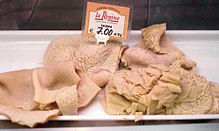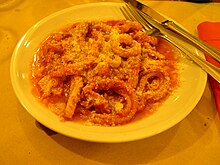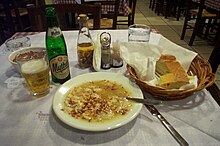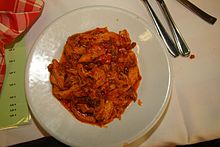Tripe

Tripe (from French tripe which is from Italian trippa) is a type of edible offal from the stomachs of various farm animals.[1][2]
Description
Beef tripe
Beef tripe is usually made from only the first three chambers of a cow's stomach: the rumen (blanket/flat/smooth tripe), the reticulum (honeycomb and pocket tripe), and the omasum (book/bible/leaf tripe). Abomasum (reed) tripe is seen much less frequently, owing to its glandular tissue content.
Other animals
Tripe may also be produced from any animal with a stomach. In some cases other names have been applied to the 'tripe' of other animals. For example tripe from pigs may be referred to as paunch.
Unwashed tripe
Unwashed (or "green") tripe includes some of the stomach's last contents, giving it an unpleasant odor and causing it to be considered unfit for human consumption. However, this content is desirable to dogs and many other carnivores and is often used in pet food.[3] Though it is called "green" because it has a high chlorophyll content, in reality it is often greyish brown as a result of other undigested compounds.
Washed tripe
Washed tripe is more typically known as dressed tripe. To dress the tripe the stomachs are cleaned and the fat trimmed off.[4] It is then boiled and bleached giving it the white colour more commonly associated with tripe as seen on market stalls and in butchers shops. The task of dressing the tripe is usually carried out by a professional tripe dresser.
Dressed tripe was a popular nutritious and cheap dish for the working classes from Victorian times up until the latter half of the twentieth century.[5][6] While still popular in many parts of the world today, the number of tripe eaters, and consequently the number of tripe dressers, in the UK has rapidly declined. Tripe has come to be regarded as a mere pet food as the increased affluence of post war Britain has reduced the appeal of this once staple food.
Dishes prepared with tripe




| Nutritional value per 100 g (3.5 oz) | |||||||||||||||||||||||||||||||||||||||||||||||||||||
|---|---|---|---|---|---|---|---|---|---|---|---|---|---|---|---|---|---|---|---|---|---|---|---|---|---|---|---|---|---|---|---|---|---|---|---|---|---|---|---|---|---|---|---|---|---|---|---|---|---|---|---|---|---|
| Energy | 355 kJ (85 kcal) | ||||||||||||||||||||||||||||||||||||||||||||||||||||
0 g | |||||||||||||||||||||||||||||||||||||||||||||||||||||
| Sugars | 0 g 0 g | ||||||||||||||||||||||||||||||||||||||||||||||||||||
| Dietary fibre | 0 g | ||||||||||||||||||||||||||||||||||||||||||||||||||||
3.69 g | |||||||||||||||||||||||||||||||||||||||||||||||||||||
| Saturated | 1.291 g | ||||||||||||||||||||||||||||||||||||||||||||||||||||
| Monounsaturated | 1.533 g | ||||||||||||||||||||||||||||||||||||||||||||||||||||
| Polyunsaturated | .180 g | ||||||||||||||||||||||||||||||||||||||||||||||||||||
12.07 g | |||||||||||||||||||||||||||||||||||||||||||||||||||||
| |||||||||||||||||||||||||||||||||||||||||||||||||||||
| Other constituents | Quantity | ||||||||||||||||||||||||||||||||||||||||||||||||||||
| Water | 84.16 g | ||||||||||||||||||||||||||||||||||||||||||||||||||||
| †Percentages estimated using US recommendations for adults,[7] except for potassium, which is estimated based on expert recommendation from the National Academies.[8] | |||||||||||||||||||||||||||||||||||||||||||||||||||||
Tripe is eaten in many parts of the world. Tripe soup comes in many varieties in the Eastern European cuisine. Tripe dishes include:
- Andouille — French poached, boiled and smoked cold tripe sausage
- Andouillette — French grilling sausage including beef tripe and pork
- Babat — Indonesian spicy beef tripe dish, could be fried with spices or served as soup as soto babat (tripe soto)
- TQallia — Moroccan spiced, seasoned in a sauce with vegetables and served on cous-cous
- Breakfast Sausages — Most commercially produced sausages in the United States contain pork and beef tripe as filler
- Bumbar — A Bosnian prepared dish where the tripe is stuffed with other cow parts.
- Butifarra — Catalonian sausage
- Callos — Spanish/Filipino tripe dish cooked with chickpea, chorizo and paprika.
- Cau-Cau — Peruvian stew of cow tripe, potaoes, mint and other spices and vegestables.
- Chakna — Indian spicy stew of goat tripe and other animal parts
- Ciorbă de burtă — Romanian special soup with cream and garlic
- Dobrada — Portuguese tripe dish usually served with white butterbeans and chouriço
- Dršťkovka (dršťková polévka) — Czech goulash-like tripe soup
- "Fasulia bil karsha" in Libya, kidney bean soup with tripe.it is a typical Libyan dish.
- Držková — Slovak tripe soup (Držková polievka)
- Dulot or Dulet - Eritrean and Ethiopian tripe and entrail stir-fry, containing finely chopped tripe, liver and ground beef, lamb or goat fried in clarified and spiced butter, with garlic, parsley and berbere.
- Ebyenda or Byenda — word for tripe in some Bantu languages of Uganda. Tripe may be stewed, but is especially popular when cooked with matooke as a breakfast dish.
- Fileki or špek-fileki — Croatian tripe soup.
- Flaki — Polish soup, with marjoram
- Fuqi feipian or 夫妻肺片— spicy and "numbing" (麻) Chinese cold dish made from various types of beef offal, nowadays mainly thinly sliced tendon, tripe and sometimes tongue
- Guatitas - Ecuadorian and Chilean tripe stew, often served with peanut sauce in Ecuador.
- Guru (food) — Zimbabwean name for tripe. Normally eaten as relish with Sadza.
- Haggis — Scottish traditional dish made of a sheep's stomach stuffed with oatmeal and the minced heart, liver and lungs of a sheep. The stomach is used only as a vessel for the stuffing and is not eaten.
- İşkembe çorbası — Turkish tripe soup with garlic, lemon and spices
- Kare-kare — Filipino oxtail-peanut stew which may include tripe
- Khash — In Armenia the widely popular winter soup is made of boiled beef tendon and honeycomb tripe and served with lots of garlic and lavash bread.
- Kista — Assyrian Cooked traditionlly in a stew and stuffed with soft rice. This dish is part of a major dish known as 'Pacha' in Assyrian. 'Pacha' is also the Persian word for the feet of hooved animals but not the hoof itself. 'Pa' is Persian for 'leg' or 'foot'. The suffix 'cha' or 'cheh' refers to something small.
- Lampredotto — Florentine abomasum-tripe dish, often eaten in sandwiches with green sauce and hot sauce.
- Machitos — Mexican tripe dish, tender or hardened and seasoned with fresh onion, cilantro, and a variety of salsas.
- Mala Mogodu — South African Cuisine - popular tripe dish, often eaten at dinner time as a stew with hot pap.
- Matumbo — Kenyan Cuisine - tripe dish, often eaten as a stew with various accompaniments.
- Mutura Kenyan Cuisine-tripe sausage, stuffed with blood, organ meat and other meats. Roasted.
- Menudo — Mexican tripe and hominy stew
- Mondongo — Latin American and Caribbean tripe, vegetable and herb soup
- Motsu — Japanese tripe served either simmered or in Nabemono
- Pacal or Pacalpörkölt — Hungarian spicy meal made of tripe, similar to pörkölt
- pacha — Iraqi, tripe stuffed with spiced rice
- Pancitas — Mexican stew similar to Menudo but made with sheep stomach
- Pancita — Peruvian spicy barbecue fried food made with cow tripe marinated with peppers and other ingredients.
- Patsás (Greek πατσάς) — Greek, similar to Turkish İşkembe
- Philadelphia Pepper Pot Soup — American (Pennsylvania) tripe soup with peppercorns
- Phở — Vietnamese noodle soup with many regional variations, some of which include tripe
- Pickled tripe — Pickled white honeycomb tripe once common in the Northeastern United States.
- Potted Meat
- Saki or Shaki — word for tripe in the Yoruba language of Nigeria. Shaki is often included in various stews, along with other meats.
- Saure Kutteln — from south Germany, made with beef tripe and vinegar or wine
- Serobe - a Botswana delicacy, mixed with intestines and in some occasions with beef meat
- Shkembe (Shkembe Chorba) (Шкембе чорба / Чкембе чорба in Macedonian) — is a kind of tripe soup, prepared in Iran, Bulgaria, Romania, Macedonia, Bosnia and Herzegovina, Serbia and Turkey. Shekam is the Persian word for stomach. Sirabi is the Iranian version of Shkembe'.
- Skembici - Serbia, one of the oldest known dishes since 13th century.Tripe in vegetable stew with herbs, served with boiled potato.
- Tripice- Croatia, stew made with Tripe, boiled with potato and bacon added for flavour.
- Tripes à la mode de Caen — in Normandy. This is a traditional stew made with Tripe in the Normandy region of France. "Tripes à la mode de Caen" obey a very codified recept, preserved by the brotherhood of "La tripière d'or"[9] that organises a competition every year to elect the world's best "Tripes à la mode de Caen" maker.
- Tripe and Beans — in Jamaica. This is a thick, spicy stew made with Tripe and Broad Beans
- Tripe and Drisheen — in Cork, Ireland
- Tripe and onion — in Northern England
- Tripe taco — Mexican sheep or calf tripe dish with tortillas
- Tripoux — French sheep tripe dish
- Trippa di Moncalieri — in Moncalieri city/Piedmont/Italy (tripe sausage, that could be served in thin slices with few drops of olive oil, minced parsley, garlic and a pinch of black pepper, or used mainly for "Trippa alla Savoiarda" recipe )
- Trippa alla fiorentina — in Italy (fried with tomatoes and other vegetables)
- Trippa alla Romana — in Italy (done with white wine and tomatoes)
- Trippa alla Savoiarda — in Piedmont/Italy (stewed with vegetables, white wine, sauce from roasted beef and served covered with grated Parmigiano Reggiano/Grana Padano cheese)
- Trippe alla Veneta (Veneto, Northeast Italy)
- Tsitsarong bulaklak — Filipino crunchy fried tripe (lit. "flower" crackling)
- Tuslama (Romanian) / Tuzlama(Turkish) - tripe stew specific to south-eastern Romania, a blend of Romanian and Turkish
- Yakiniku and Horumonyaki — Japanese chargrilled, bite-sized
- Vampi — Slovenian tripe stew.
- Vette darmen Traditional, though now on the verge of being obsolete West-Flemish dish. The tripe is seasoned and fried in a buttered pan.
- Ojree — Pakistani curry made out of finely chopped and tenderized goat tripe
- Obe ata pelu Shaaki — Nigerian Stew made with large chunk of cow and goat tripe
- Pepper soup with tripe — Nigerian Hot peppered liquid soup with bite-sized tripe
- 牛肚 / 金錢肚 (Mandarin: Niudu/Jinqiandu; Cantonese, Ngautou/Gumtsintou) -- Chinese cuisine Tripe with inner lining resembling ancient Chinese coin with square hole give its name: "coin stomach". The dish is usually served steamed with spring onion and garlic sauce, or just boiled in water served with sweet soya sauce with chilli and spring onions as a dipping sauce.
- Tripe soup Shorbet Kawari3; in Jordan. This is a stew made with Tripe and tomato sauce
Tripas
In Spanish- and Portuguese-speaking countries, the close cognate "tripas" tends to denote small intestines rather than stomach lining. Dishes of this sort include:
- Tacos de tripa — Mexican tacos filled with soft or crunchy fried small intestines
- Tripas à moda do Porto — small intestines with white beans, in Portuguese cuisine, a dish typical of the city of Porto.
- "Callos"; 'Tripe' with chickpeas, black pudding and spicy sausage. Mainly eaten in Andalucia.
Nutritional value
Green tripe is highly recommended by the advocates of raw food for dogs. In an analysis of a sample of green tripe by a Woodson-Tenant Lab in Atlanta, Georgia, it was discovered that the calcium:phosphorus ratio is 1:1, the overall pH is on the acidic side which is better for digestion, protein is 15.1, fat 11.7 and it contained the essential fatty acids, linoleic and linolenic, in their recommended proportions. Also discovered was the presence of lactic acid bacteria, known as lactobacillus acidophilus, which is a beneficial intestinal bacteria and a common ingredient in probiotics. [citation needed]
See also
- Chitterlings (Chitlins)
References
- ^ "Troppa Trippa". History of tripe, worldwide tripe recipes. Neri Editore, Firenze. 1998. Retrieved 2007-07-21.
- ^ Driscoll, Michael (May 2003). A Child's Introduction Poetry. 151 West 19th Street New York, NY 10011: Black Dog & Leventhal Publishers. p. 12. ISBN 1-57912-282-5.
{{cite book}}: Unknown parameter|coauthors=ignored (|author=suggested) (help)CS1 maint: location (link) - ^ "Main Index". Greentripe.com. Retrieved 2012-08-20.
- ^ IFIS Dictionary of Food Science and Technology. Wiley-Blackwell. 2009. ISBN 978-1-4051-8740-4.
- ^ "Butchers Hook". Retrieved 26 March 2012.
- ^ Houlihan, Marjorie (2011). A Most Excellent Dish (The English Kitchen). Prospect Books. ISBN 978-1-903018-81-1.
- ^ United States Food and Drug Administration (2024). "Daily Value on the Nutrition and Supplement Facts Labels". FDA. Archived from the original on 2024-03-27. Retrieved 2024-03-28.
- ^ National Academies of Sciences, Engineering, and Medicine; Health and Medicine Division; Food and Nutrition Board; Committee to Review the Dietary Reference Intakes for Sodium and Potassium (2019). Oria, Maria; Harrison, Meghan; Stallings, Virginia A. (eds.). Dietary Reference Intakes for Sodium and Potassium. The National Academies Collection: Reports funded by National Institutes of Health. Washington, DC: National Academies Press (US). ISBN 978-0-309-48834-1. PMID 30844154. Archived from the original on 2024-05-09. Retrieved 2024-06-21.
- ^ a http://www.ville-caen.fr/Tourisme/tripiereOr/index.asp
